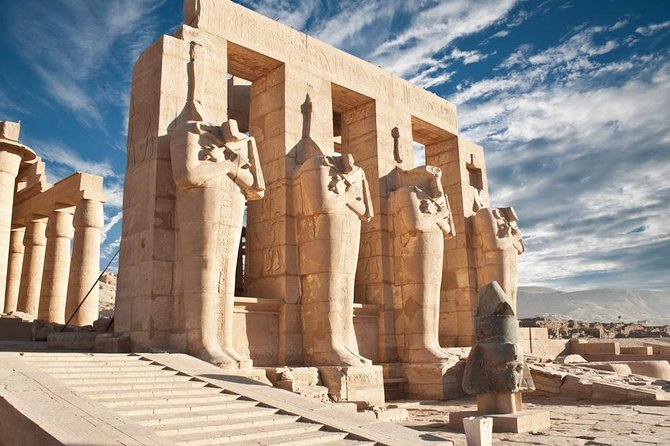
Exploring the Enigmatic Ramesseum: Unveiling Ancient Marvels
Ramesseum is an awe-inspiring monument that embodies ancient Egypt’s magnificence. Nestled on the western bank of Luxor , this colossal funerary temple was built by Pharaoh Ramesses II during the 13th century BC. This impressive structure is an incredible feat of engineering and architecture, with gigantic columns and elaborate carvings. It was dedicated to the pharaoh’s memory and is still one of ancient Egypt’s most popular tourist attractions. We invite you to join us as we explore the Ramesseum’s mysteries and marvels.
1-The Legacy of Ramses II
Ramses II, also known as Ramses the Great, was one of ancient Egypt’s most powerful and celebrated pharaohs. His reign lasted an impressive 66 years, and his impact on Egyptian history and culture is immeasurable. The Ramesseum was built as a mortuary temple to honor Ramses II and ensure his eternal legacy.
2-A Glimpse Into the Past
Step back in time as we delve into the historical context of the Ramesseum. Discover the reign of Ramesses II, one of Egypt’s most celebrated pharaohs, and the motivation behind the construction of this magnificent temple complex. Uncover the religious beliefs and practices that shaped the temple’s design and purpose.
3- History and Significance
The Ramesseum holds immense historical and cultural significance. It was dedicated to the god Amun and served as the final resting place for Ramesses II, one of ancient Egypt’s most powerful pharaohs. Its construction spanned over 2 decades, showcasing the remarkable architectural skills and artistic mastery of that era.
4- Architectural Marvels
Step into the Ramesseum and be transported back in time. The grand entrance, adorned with towering statues of Ramesses II, sets the tone for the architectural splendor that awaits. The temple’s inner sanctum features intricate hieroglyphics, meticulously carved reliefs and captivating wall paintings that depict scenes from ancient Egyptian mythology and royal ceremonies.
5- Exploring the Courtyards
Venturing further into the Ramesseum, we discover its vast courtyards, once bustling with activities. The central courtyard, surrounded by stately columns, was a space for religious rituals and gatherings. As we wander through the temple’s various chambers and halls, we encounter chapels dedicated to different deities, each with its unique charm and significance.
6-Mysteries Within the Walls
Peel back the layers of mystery surrounding the Ramesseum. Learn about the hidden chambers, underground passages, and secret chambers that have piqued the curiosity of archaeologists and historians for centuries. Delve into the theories and speculations surrounding these enigmatic features, allowing your imagination to wander through the hidden recesses of this ancient temple.
7-The Sacred Purpose
Within the Ramesseum, various chambers and sanctuaries were dedicated to religious rituals and worship. The temple served as a place of reverence for the gods, particularly Amon-Ra, the principal deity of ancient Egypt. The intricate wall carvings and hieroglyphics found within the temple walls provide valuable insights into the religious beliefs and practices of the time.
8- The Colossus of Ramesses II
One of the Ramesseum’s most iconic features is the colossal statue of Ramesses II which lies in ruins. Originally standing at an impressive height of 17 meters, this statue showcased the might and authority of the pharaoh. Despite the passage of time and the effects of nature, the remnants of this monumental statue continue to inspire awe and wonder.
An ancient Egyptian masterpiece, the Ramesseum shows the ingenuity and artistic brilliance of the civilization. Taking a look at their rich history, culture, and religious beliefs is fascinating. Exploring this magnificent temple is a journey that unravels the mysteries of the past and ignites a sense of wonder within us. The Ramesseum is not merely a structure of stone and mortar, but a gateway to the ancient world that continues to captivate and inspire generations.

